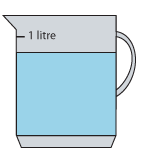Opportunities to use and apply
Possible contexts include:
- cooking, e.g. Estimating the correct quantities for recipes.
- shopping, e.g. Estimating the mass of fruit and vegetables and then weighing them.
- PE lessons, e.g. Estimating a distance that has been jumped, or how far a beanbag has been thrown.
Confirming learning
Ask probing questions such as:
- ‘A tall, narrow container must hold more than a short, wide one.’ Is this statement true? Can you provide examples to help you explain why?
- Look at how much water is left in the jug. Estimate how many millilitres of water are left. Explain your thinking.

- Provide a range of items (including some that are small and heavy and some that are large and light) and a 1-kg weight. Ask: ‘Can you order these from lightest to heaviest and estimate the weight of each item? Weigh the objects to see how accurate you were.’
 Measuring
Measuring







